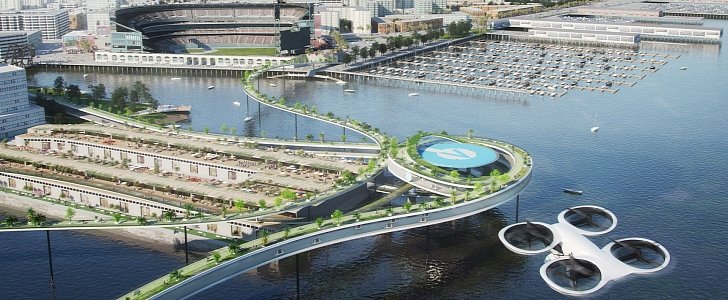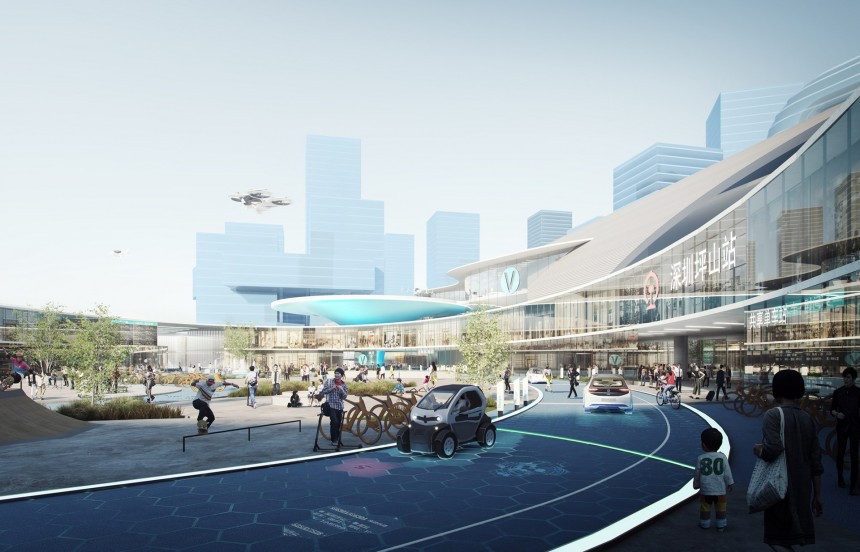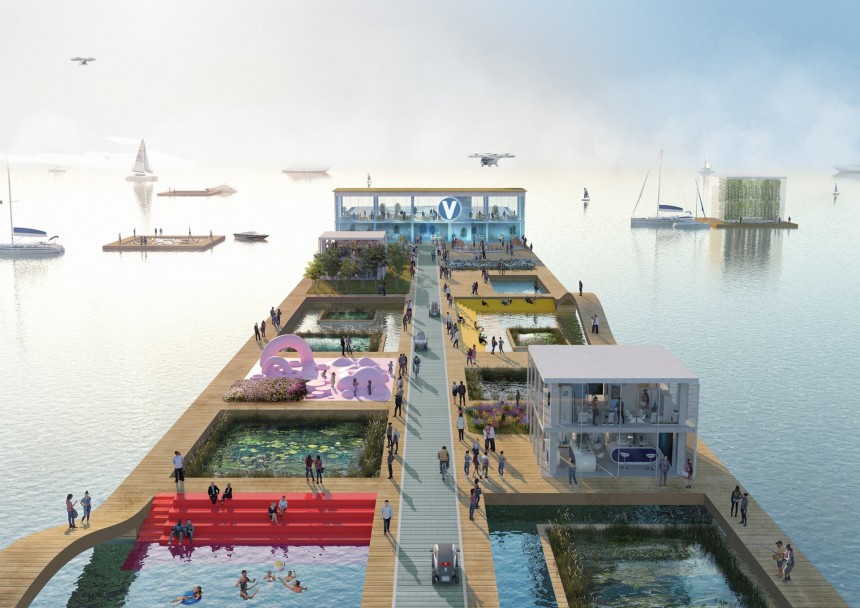As cities become more congested and polluted, it’s become clear that humanity must look up to the skies for a truly efficient, more eco-friendly means of transport. Enter the decades-old dream of flying cars.
The eVTOL (Electric Vertical Take-Off and Land vehicle) market is expanding, with the earliest models expected to be fully functional in 2025 – but ready and submitted for regulation in 2023. Various notable breakthroughs have already been made, bringing man’s dream of a flying car (more or less) closer to reality.
But what happens when these flying cars become norm and they overrun an already overwhelmed infrastructure?
For the past 2 years, architecture design firm MVRDV and Airbus, in partnership with Bauhaus Luftfahrt, ETH Zurich and Systra, have been researching and designing a foolproof plan that will unlock the full potential of urban air mobility (UAM). Called Urban Air Mobility (UAM) City Integration, the research looks at vertiports as the key to a successful integration and maximization of the new means of transport.
Vertiports are exactly what they sound like: vertical landing hubs – and fancy ones, while we’re at it. The idea is to create versatile hubs that serve a variety of purposes, without adding further stress to the existing infrastructures but bring about further development. Previous approaches to the issue were in the wrong because they assumed UAM should replace existing means of transport. It shouldn’t: it must complement it.
The research notes that these vertiports would be accessible by people from all backgrounds, and positively impact all categories. They’re not exclusive to the helicopter-chartering elite, but help to bridge the gap between the rich and the poor, while cutting down on pollution.
“Vertiports are thought of not just as stations, but also as hubs of renewable energy, data, and public amenities, that can scale while remaining sustainable and resilient,” the research notes. “Air transport incentivizes an ecologically responsible contribution to the local smart grids of energy and data.”
Vertiports would come to supplement the existing aerial network, but also current and future ground infrastructures. They would help with last-mile mobility as well, in that they would be accessible from one’s balcony – because MVRDV imagines they would come in all shapes and sizes. In that, they’re similar to traditional transport spots, whether they’re airport terminals or bus stations, but they wouldn’t require tunnels, roads or tracks in between, which translates into “saving energy, natural resources, and land.”
“This allows designers to adapt the vertiports to a variety of different locations, plugging into and enhancing existing urban scenarios with a number of different configurations,” the paper notes.
The versatility of vertiports would bring about countless improvements. Underdeveloped locations or communities could receive extra support by having vertiports fitted with educational and healthcare facilities. Developing countries could benefit from “technological leapfrogging” through a network of vertiports. Disadvantaged or remote areas could connect to a city without the need of extra funding and resources for infrastructure. Emergency response times would be improved considerably.
More importantly though, this three-dimensional way of looking at public and personal transport would be greener than anything we have right now, either in the air or on the ground. Building a network of vertiports together would require fewer resources and would prove more sustainable.
“As cities become denser and technologies improve, it becomes increasingly clear that the truly three-dimensional city – one that includes flying vehicles – is surely one of the city models of the future… a city where my mobility is at my balcony!” Winy Maas, founding partner of MVRDV, writes in the paper.
For the time being, vertiports are still a concept, but Airbus is one of the many companies looking into urban air mobility solutions. It’s currently operating Voom, an on-demand helicopter booking platform, and working on developing an autonomous, electric air taxi passenger drone. By 2025, it will probably be one of the big players to have materialized the dream of flying cars – and will need somewhere to land all of them.
But what happens when these flying cars become norm and they overrun an already overwhelmed infrastructure?
For the past 2 years, architecture design firm MVRDV and Airbus, in partnership with Bauhaus Luftfahrt, ETH Zurich and Systra, have been researching and designing a foolproof plan that will unlock the full potential of urban air mobility (UAM). Called Urban Air Mobility (UAM) City Integration, the research looks at vertiports as the key to a successful integration and maximization of the new means of transport.
The research notes that these vertiports would be accessible by people from all backgrounds, and positively impact all categories. They’re not exclusive to the helicopter-chartering elite, but help to bridge the gap between the rich and the poor, while cutting down on pollution.
“Vertiports are thought of not just as stations, but also as hubs of renewable energy, data, and public amenities, that can scale while remaining sustainable and resilient,” the research notes. “Air transport incentivizes an ecologically responsible contribution to the local smart grids of energy and data.”
“This allows designers to adapt the vertiports to a variety of different locations, plugging into and enhancing existing urban scenarios with a number of different configurations,” the paper notes.
The versatility of vertiports would bring about countless improvements. Underdeveloped locations or communities could receive extra support by having vertiports fitted with educational and healthcare facilities. Developing countries could benefit from “technological leapfrogging” through a network of vertiports. Disadvantaged or remote areas could connect to a city without the need of extra funding and resources for infrastructure. Emergency response times would be improved considerably.
More importantly though, this three-dimensional way of looking at public and personal transport would be greener than anything we have right now, either in the air or on the ground. Building a network of vertiports together would require fewer resources and would prove more sustainable.
For the time being, vertiports are still a concept, but Airbus is one of the many companies looking into urban air mobility solutions. It’s currently operating Voom, an on-demand helicopter booking platform, and working on developing an autonomous, electric air taxi passenger drone. By 2025, it will probably be one of the big players to have materialized the dream of flying cars – and will need somewhere to land all of them.
















